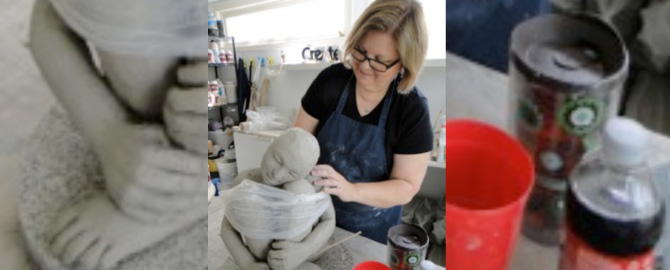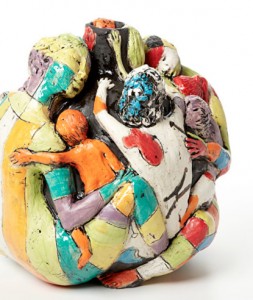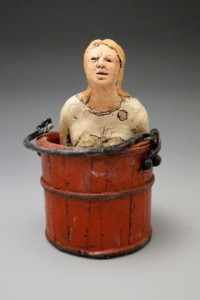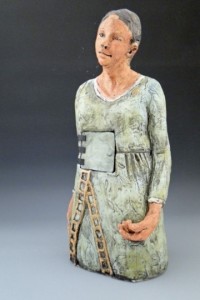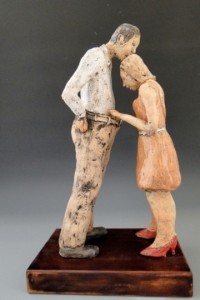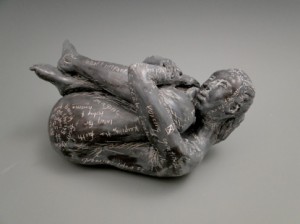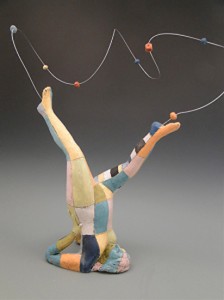Linda Lewis’s works deal with human emotions. She is an observer, studying emotions, expressions, interactions between loved ones and the bond between mother and child. Lewis’s ceramic sculptures are narratives – three-dimensional sketches that pick up the subtleties of body language that are pieced together from recollections, memories, observations and past experiences. The words community, family and passion resonate from her pieces.
The colourful sculptures are textural and earthy pieces – the surfaces are cracked, with an honest and bucolic feel. For 34 years Lewis worked as an educator in the Des Moines Schools until she took a workshop given by a narrative sculptor in Santa Fe. In 2011 Lewis won Best of Show in the National clay, paper, textile, wood, glass, metal exhibition, Octagon Center, Ames LA.
In her own words
How you became an artist. – Did you start as a Sculptor or a Ceramicist and has this is a conscious decision to fuse these disciplines together?
I think probably most artists would probably say they were an artist from a young age. I grew up in a middle class family with parents who had few experiences with art and the elementary and middle school I attended did not have an art program so I was left to my own devices. Instead of experiences with sculpture I made villages and structures in the sand box. Instead of making art projects, my brothers and I dug out clay from the banks of a creek and spent hours making things. Instead of attending art classes (that were not available in my area) my parents bought me pastels, paints and paper and let me ‘go at it’ on my own with no restrictions. I had little exposure to art yet somehow found my way to it because of the love of making things. I always thought about how to represent ideas in a visual manner more than in written or verbal form. When I attended college for an education degree I realized I could actually take classes in the art department as well so ended up getting an art minor for the sheer pleasure, again, of making things.
I had a wonderful career in teaching, received a graduate degree in administration, raised 4 children with my husband and was satisfied with my life as it was until one day I got the notion that I wanted to do something beyond what I had already done. I began working with clay and found a real interest in expressing myself through making narrative figures. I had painted for myself and for friends but when I began to make figures it was as if I found myself in the right ”home.’
You use people as the focus of the work. What makes you choose certain people for your work- is it their face, backgrounds, achievements or relationship with yourself?
I worked in elementary schools for years so worked with a wide range of people, children and parents – this gave me lots of material for ideas that could be transformed in a visual way. I found that there were common links between people- common wants and desires – simple things yet profoundly important to each individual. I start with an idea, a phrase or a concept and figure out how it can be represented and what position/or shape, surface or texture, markings, and colors will support the concept
What do you try to capture when creating a sculpture?
I like capturing an idea visually in a way that links one person to another. When people approach my work I want people to think, to wonder, to want to know more, to create their own story or imagery – maybe even to laugh. By incorporating symbolism within the piece it allows me to express myself without the use of words . I find this tremendously satisfying.
What elements do you find most challenging in your work and how do you overcome them?
There are some limitations with clay and what it can do, but I find that part intriguing. I like the idea of limitations because of the challenge of finding a solution and sometimes even to fail. I have a not so big electric kiln so there is the challenge of creating what I want in a limited size but also a surface that has some depth because of the low fire, oxidation environment. I’m not afraid to break some traditional ceramic rules and fail, so I think I end up making more interesting pieces.
Obviously the figure has been a huge muse for many artists throughout the history or art. What artists or professionals have been your biggest influences?
Because I had another life in a field other than art and because I was in my mid fifties when I started working with clay I decided to work with professional artists in a week-long workshop structure. This has given me the opportunity to focus just on making clay figures, removed from the demands of everyday life. I’ve worked with figurative clay artists such as Deborah Fritz, Janis Mars-Wunderlich, Andy Nacisse, Judy Fox, Esther Shimazu, Lisa Reinertson, and Claudia Olds Goldie.
Where do you hope to take your work in the next few years?
I plan to be more experimental with surfaces and with how I represent people’s ideas. I have an interest in creating a series of small groups of diverse people in scenarios working, living or socializing near each other and using more simplified shapes and forms.
Linda Lewis can be found working in her studio at her home in West Des Moines where she lives with her husband Vincent. They have four grown children and five grandchildren.
All images courtesy of Linda Lewis | www.lindalewisart.com
For more information on Hong Kong Art Tutoring please contact:
Gail Deayton
Telephone: +852 9722 8353
Email: gd@gaildeayton.com

